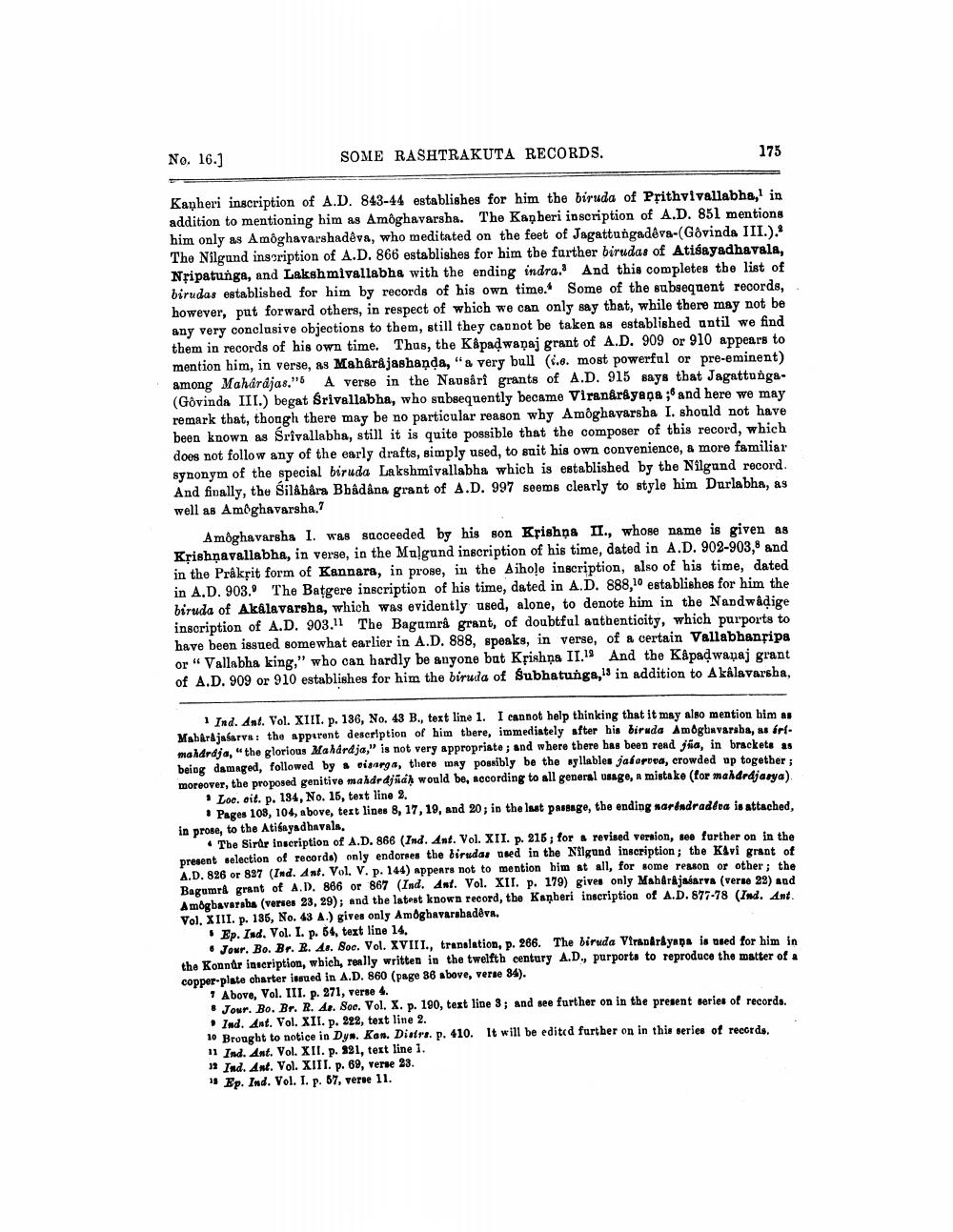________________
No. 16.)
SOME RASHTRAKUTA RECORDS.
175
Kayheri inscription of A.D. 843-44 establishes for him the biruda of Přithvivallabha,' in addition to mentioning him as Amôghavarsha. The Kaņberi inscription of A.D. 851 mentions him only as Amôghavarshadêva, who meditated on the feet of Jagattungadêra-(Govinda III.). The Nilgund inscription of A.D. 866 establishes for him tbe further birudas of Atibayadhavala, Nřipatunga, and Lakshmivallabha with the ending indra. And this completes the list of birudas established for him by records of his own time. Some of the subsequent records, however, put forward others, in respect of which we can only say that, while there may not be any very conclusive objections to them, still they cannot be taken as established until we find them in records of his own time. Thas, the Kåpadwanaj grant of A.D. 909 or 910 appears to mention him, in verse, as Maharajashanda, "& very bull (1.6. most powerful or pre-eminent) among Maharajas."5 A verse in the Nausari grants of A.D. 915 says that Jagattunga(Govinda III.) begat Srivallabha, who subsequently became Viranår yaşa ; and here we may remark that, though there may be no particular reason why Amôghavarsha I. should not have been known as Srivallabha, still it is quite possible that the composer of this record, which does not follow any of the early drafts, simply used, to suit his own convenience, & more familiar synonym of the special biruda Lakshmivallabhs which is established by the Nilgund record. And finally, the sildhåra Bhâdâna grant of A.D. 997 seems clearly to style him Durlabha, as well as Amoghavarsha.?
A môghavarsha I. was succeeded by his son Krishna II., whose name is given as Krishṇavallabha, in verse, in the Mulgand inscription of his time, dated in A.D. 902-903,9 and in the Prâksit form of Kannara, in prose, in the Aihole inscription, also of his time, dated in A.D. 903. The Batgere inscription of his time, dated in A.D. 888,10 establishes for him the biruda of Akalavarsha, which was evidently used, alone, to denote him in the Nandwadige inscription of A.D. 903.11 The Bagamrå grant, of doubtful authenticity, which purports to have been issued somewhat earlier in A.D. 888, speaks, in verse, of a certain Vallabhansipe or " Vallabha king," who can hardly be anyone but Krishna II.1 And the Kapad wanaj grant of A.D. 909 or 910 establishes for him the biruda of Subhatunga, in addition to A kalavarsha,
1 Ind. Ant. Vol. XIII. p. 136, No. 43 B., text line 1. I cannot help thinking that it may also mention him as MabArAjafarva: the apparent description of him there, immediately after his biruda Amoghavarsba, as árf. mahdrdja," the glorious Mahardja," is not very appropriate ; and where there has been rend jfia, in brackets as being damaged, followed by pisargs, there may possibly be the syllables jalostea, crowded up together; moreover, the proposed genitive maldrdji would be, according to all general usage, a mistake (formaldrdjarya)
• Loc. oit. p. 134, No. 15, text line 2.
• Pages 108, 104, above, text lines 8, 17, 19, and 20; in the last passage, the ending narindradea is attached, in prose, to the Atifayadhavals.
The Sirur inscription of A.D. 866 (Ind. Ant. Vol. XII. p. 216 ; for revised version, see further on in the present selection of records) only endorses the dirudas used in the Nilgund inscription; the Kivi grant of A.D. 826 or 897 (Ind. Ant. Vol. V. p. 144) appears not to mention him at all, for some reason or other; the Bagumrå grant of A.D. 866 or 867 (Ind. Ant. Vol. XII. p. 179) gives only Mah&r&jaśarva (verse 22) and Amog bavarsha (verses 23, 29); and the latest known record, the Kamberi inscription of A.D. 877-78 (Ind. Ant. Vol. XIII. p. 186, No. 43 A.) gives only Am@ghavarsbadeva.
Ep. Ind. Vol. I. p. 54, text line 14.
• Jour. B. Br. R. A. Soc. Vol. XVIII., translation, p. 266. The biruda Virspiryapa is used for him in the Konnar inseription, which, really written in the twelfth century A.D., purporta to reproduce the matter of a copper-plate charter issued in A.D. 860 (page 86 above, verne 84).
1 Above, Vol. III. p. 271, verse 4. • Jour. Bo. Br. R. 41. Soc. Vol. X. p. 190, text line 3; and see further on in the present series of records. . Ind. Ant. Vol. XII. p. 222, text line 2. 10 Brought to notice in Dys. Kon. Didrs. p. 410. It will be edited further on in this series of records. 11 Ind. Ant. Vol. XII. p. 321, text line 1. 12 Ind. Ant. Vol. XIII. p. 69, verse 23. " Ep. Ind. Vol. I. p. 87, verse 11.




